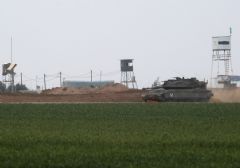Share
Human Rights Voices
While the UN devotes its human rights operations to the demonization of the democratic state of Israel above all others and condemns the United States more often than the vast majority of non-democracies around the world, the voices of real victims around the world must be heard.
Palestinian Authority/Gaza, February 17, 2018
4 IDF soldiers wounded after explosive device detonated near Gaza border
Original source
In what may be the most serious incident on the Gaza front since Operation Protective Edge in 2014, four soldiers were wounded when a bomb was detonated against their military jeep as they patrolled the border fence on Saturday afternoon.
Two soldiers were in serious condition, one was moderately wounded, and one was lightly wounded, the army said. They were evacuated by helicopter to Soroka-University Medical Center in Beersheba.
"This was a severe terrorist attack that has the potential to destabilize the region," IDF Spokesman Brig.-Gen. Ronen Manelis said. A situational assessment had been carried out by IDF Chief of Staff Lt.-Gen. Gadi Eisenkot, OC Southern Command Maj.-Gen. Eyal Zamir, OC Air Force Maj.-Gen. Amikam Norkin and other officers, Manelis said.
Prime Minister Benjamin Netanyahu, in Munich for a security conference, said, "The incident on the Gaza border was a very serious one. We will respond in kind. I am sending to the wounded my wishes for a speedy recovery."
The attack took place around 4 p.m., east of Khan Yunis and the southern Gaza Strip, when the patrol from the Golani Brigade arrived to investigate a suspicious flag that was spotted on the Palestinian side of the fence, following protests that broke out along the border on Friday.
While the flag, to which the improvised explosive device was attached, was spotted on the Gaza side of the fence, the troops were on the Israeli side when it detonated.
"I will not say whether this incident calls for a stronger response, I will let the planes give that answer," Manelis said, when asked if there would be additional retaliatory strikes.
Soon after that, Palestinian media reported several air strikes in the Gaza Strip against Hamas positions.
The IDF carried out large-scale strikes against six terrorist targets belonging to Hamas, including an attack tunnel in the Zeitun neighborhood of Gaza City that was dug toward Israeli territory.
The air force also attacked a Hamas military compound in the Netzarim area that included a weapons manufacturing sites, and another Hamas military compound in Khan Yunis.
Late on Saturday night, rocket warning sirens sounded in several Gaza border communities, with unconfirmed reports that at least four mortar shells were fired from Gaza toward Israeli territory.
Manelis said that while the IED is not believed to have been placed by either Hamas or Islamic Jihad, Israel hold Hamas responsible for everything that occurs "under and above the Gaza Strip."
Hamas is responsible for bringing demonstrators to the "spontaneous" protests held in recent weeks along the Israel-Gaza border, he said.
These demonstrations have been getting more violent in recent weeks, with protesters bringing firearms and grenades to use against IDF troops on the other side of the fence, the army said.
"These spontaneous demonstrations are also used for terrorist activity, and these events will be met with an uncompromising response," Manelis warned.
The IDF Spokesperson's Unit said, "The IDF views with great severity the attempt by Hamas to carry out seemingly spontaneous demonstrations intended to turn the fence into a confrontation zone and carry out acts of terrorism that would destabilize the Gaza Strip."
Maj.-Gen. Yoav "Poli" Mordechai, the coordinator of government activities in the territories, took to Facebook, calling the IED attack one of "cowardice" and warning the civilian population in Gaza against the ongoing manipulation and exploitation by Hamas, calling on them to "wake up."
A statement from the Eshkol Regional Council, whose jurisdiction includes the area of the attack, stressed that there were no ramifications for residents and no changes to security instructions, as it "was a military incident that occurred on the border."
Although tension has increased on the Gaza border in recent months, the discovery and detonation of IEDs along the fence is rare. Since the end of Operation Protective Edge, one IED was discovered in early 2015, another in April 2016 and another two in March 2017.
The two IEDs discovered last year were "neutralized" after they were found in a closed military zone near the northern Gaza Strip. The charges were then taken for further examination. No one was injured.
While the security establishment does not believe that Hamas currently seeks another, the situation is fragile, especially given the worsening conditions in the Strip.
Earlier this month, Eisenkot warned a cabinet meeting that a war with Hamas could take place this year if the Gaza Strip's dire economic and humanitarian situation is not ameliorated.
The IDF chief added that rehabilitation of the Strip must first be preceded by the return of the bodies of two Israeli soldiers, Lt. Hadar Goldin and St.-Sgt. Oron Shaul, as well as the release of Israeli civilians Avraham Abera Mengistu, Hisham al-Sayed and Juma Ibrahim Abu Ghanima, all of whom are being held captive in Gaza.
According to senior IDF officers, the humanitarian situation in the Gaza Strip is the worst it has been in decades. Unemployment is at 46%, and those who find work earn an average monthly salary of just over $400. Nearly 80% of Gaza residents receive some form of aid.
The Rafah crossing with Egypt has remained mostly closed since 2013, and the number of trucks entering the Strip from Israel's Kerem Shalom crossing, the sole commercial crossing into the enclave, has in recent months dropped from between 800-1,200 trucks per day to 300-400 trucks.

